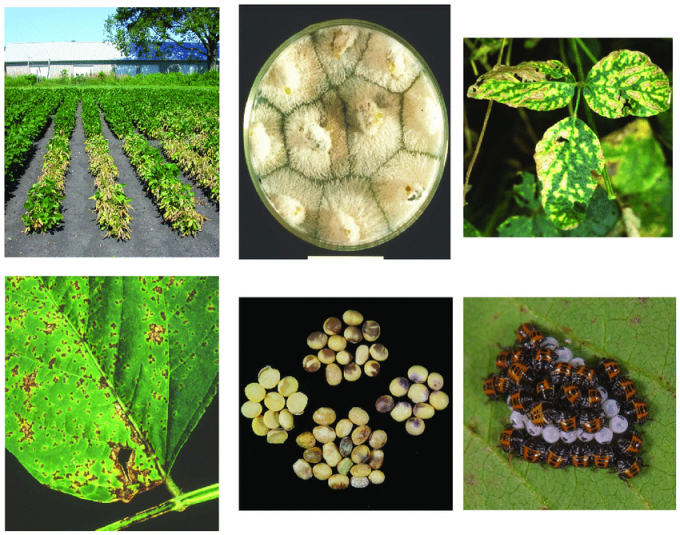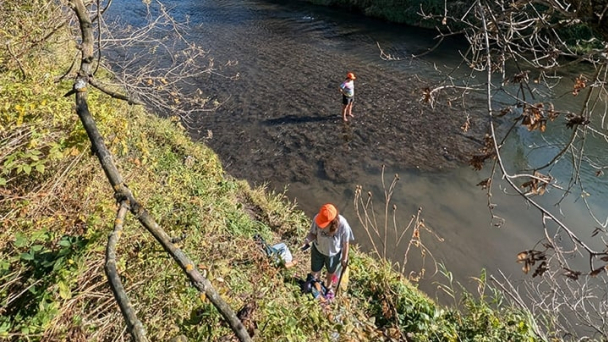May 14, 2025 | 09:17 GMT +7
May 14, 2025 | 09:17 GMT +7
Hotline: 0913.378.918
May 14, 2025 | 09:17 GMT +7
Hotline: 0913.378.918

Examples of soybean diseases and insect pests found in organically produced soybean. Top right from left to right: Sclerotinia stem rot, soybean cyst nematode, and the soybean aphid. Middle right to left: Phytophthora root and stem rot, Phomopsis seed decay, and sudden death syndrome. Bottom right to left: soybean rust, seed abnormalities, and marmorated stink bug nymphs. Photo: Researchgate.net
No more. Hidden soybean diseases that often surface in August may prompt farmers to instead shift R&R plans postharvest. Mid- to late-season diseases can turn a deep green-hued soybean into a scarred and chlorotic mess by August’s end.
Preemptive fungicide applications can preserve yield potential with some diseases, such as white mold. Other diseases, including sudden death syndrome (SDS, above), are beyond a farmer’s control. Still, August scouting can help nix disease potential in subsequent years through selection of resistant or tolerant varieties, fungicides, and seed treatments.
FROGEYE LEAF SPOT
Frogeye leaf spot used to be limited to Mid-South states, such as Arkansas, Kentucky, and Tennessee. “Before it was confirmed [in North Dakota] in 2020, we never even talked about it,” says Sam Markell, North Dakota State University Extension plant pathologist.
No more. Although yield losses are often scant with leaf diseases, this leaf disease can slice yields up to 30% during wet years, according to Bayer Crop Science findings. It’s estimated that this residue- and seed-borne fungal disease inflicted an estimated $100 million in damage in the North Central and Mid-South regions of the United States in 2019, says Markell.
“It likes hot and humid conditions, which is one reason we saw a lot of it in 2020 in North Dakota,” he says. “When we walked around fields in late August, we started seeing these spots with grayness in the middle and a dark purple-brownish ring on the outside. We’d seen spots on soybeans before, but this was different.”
Resistant varieties are one way to combat frogeye leaf spot. Fungicides are another option, although widespread frogeye leaf spot resistance to Qol (strobilurin) fungicides complicates this tool.
“If you see frogeye leaf spot in your [Iowa] field, chances are it is 100% resistant to Qol fungicides,” says Daren Mueller, Iowa State University Extension plant pathologist.
Strobilurin-resistant frogeye leaf spot even surfaces in states where it’s just been recently confirmed, such as North Dakota. About 25% of 300 samples of 2020 soybeans infected with frogeye leaf spot that Markell sent to a University of Kentucky laboratory were resistant to strobilurin fungicides. Thus, farmers and applicators should include a fungicide with a DMI (triazole) or a SDHI mode of action.
It’s unknown how well the frogeye leaf pathogen overwinters in cold climates like North Dakota. “This can influence how early the disease appears in the season,” says Markell. Early appearance can greatly influence potential yield loss, he says.
BROWN STEM ROT
Not surprisingly, brown stem rot (BSR) is characterized by internal stem browning, akin to lead in a pencil, says Markell.
Visual symptoms, such as leaf defoliation and premature maturation, can be similar to SDS. However, symptoms are not always visible on leaves, he says.
Cool weather during flowering favors infections, he adds. Like SDS, soybean cyst nematode (SCN) can enhance BSR. Soil pH levels less than 6.5 also encourage brown stem rot. Left unchecked, BSR can clip yields more than 30%, but yield losses of 10% to 20% are more common, says Dean Malvick, University of Minnesota (U of M) Extension plant pathologist.
“It’s often under-recognized and under-managed, even though we have some very good varieties that have high levels of resistance,” he says. Rotating with corn or other crops is another good management option, he says.
SUDDEN DEATH SYNDROME
Since being discovered in Arkansas in 1971, sudden death syndrome (SDS) has trekked northward.
“It’s intimately linked with soybean cyst nematode,” says Markell. “So as SCN expands, you often expect SDS to show up later.”
Its first visible symptom is chlorotic leaves that appear in August. In reality, SDS infects soybeans much earlier. Favored by wet spring weather, this soilborne fungal pathogen invades the roots of soybean seedlings. It produces a toxin that spreads through the plant, which spurs chlorosis and leaf defoliation months later.
“Another symptom of SDS is that just petioles remain on the plant because all leaves have dropped,” says Markell. “Yield losses can be pretty devastating.”
ISU and U of M plant pathologists note SDS can cause up to 40% yield losses, especially when symptoms develop early.
Laboratory confirmation is best when a farmer suspects SDS is infecting soybeans. This requires sending roots to the lab, as it is a root disease, says Markell.
The best way to manage SDS is by planting resistant varieties, say Mueller and Malvick.
Resistant varieties showed a 15.1% yield advantage over susceptible ones on fields with an SDS history in university trials at around 50 locations from 2013 to 2019 in Illinois, Indiana, Iowa, Michigan, South Dakota, Wisconsin, and Ontario.
Ilevo and Saltro seed treatments are also ways to manage SDS. Because SCN is linked to SDS, taking steps to manage SCN, such as planting SCN-resistant varieties, is another way to manage SDS, adds Markell.
STEM CANKER
Stem canker infections normally surface between mid-July and maturity, particularly under wet and cool weather.
“Reddish-brown lesions form at the base of branches or leaf petioles,” says Malvick. “These develop into elongated brown cankers that often girdle the stem and kill it.”
Farmers and crop scouts may confuse symptoms with Phytophthora root rot, although it doesn’t rot roots the way Phytophthora does, says Malvick.
Stem canker can cut yield up to nearly 50% on susceptible varieties under favorable conditions, according to the Crop Protection Network (CPN), a multistate and international partnership of university and provincial Extension specialists and public and private crop professionals.
Cool and wet weather favors the onset of stem canker, as does conservation tillage, which provides a residue haven for fungal pathogens that spawn stem canker. Although it can rub conservation tillage backers the wrong way, tillage can alleviate stem canker outbreaks. Fungicide-treated seed also can alleviate problems. Seed companies also sell resistant and moderately resistant varieties to stem canker, Malvick says.
WHITE MOLD
One bright spot if the early summer scorching drought in many areas continues: There likely won’t be much white mold in soybeans.
The fungal disease needs cool and wet weather for the white mold fungus to infect soybeans. That’s good news for soybean farmers. For every 10% increase in the incidence of white mold observed at R7 (beginning maturity) growth stage, yield can be reduced by 2 to 5 bushels per acre, according to Crop Protection Network data.
“There are some varieties that tolerate white mold better than others,” says Sam Markell, North Dakota State University Extension specialist. “Fungicides can also be a good tool, especially when cool and wet conditions are expected.”
For best results, spray a fungicide when 80% of plants are flowering during the R1 stage (beginning bloom), says Randy Myers, Bayer agronomic solutions manage.
(SF)

(VAN) India is concerned about its food security and the livelihoods of its farmers if more US food imports are allowed.

(VAN) FAO's Director-General emphasises the need to work together to transform agrifood systems.

(VAN) Europe is facing its worst outbreak of foot-and-mouth since the start of the century.

(VAN) The central authorities, in early April, released a 10-year plan for rural vitalization.

(VAN) Viterra marked a significant milestone in its carbon measurement program in Argentina, called Ígaris, reaching 1 million soybean hectares measured.

(VAN) Minnesota study adds to growing evidence of human-accelerated erosion, which could jeopardize agriculture.

(VAN) QU Dongyu addresses International Conference of the Global Mountain Dialogue for Sustainable Development in Kyrgyzstan.